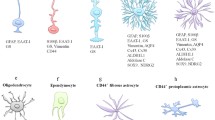Abstract
Astrocytes, the most abundant cell type in the brain, proliferate during brain development. While it is generally accepted that mature astrocytes do not proliferate, neural stem cells, which have characteristics of astrocytes, retain the ability of self-renewal. Furthermore, astrocytes can regain their proliferative properties under pathological situations, such as reactive astrogliosis, a consequence of brain injury and brain tumors. Measurements of astrocyte proliferation can thus be used in investigations of physiological and pathological processes occurring in the developing and the adult brain. This chapter describes two methods for the determination of astrocyte proliferation: the incorporation of a radioactive nucleotide [3H]thymidine into DNA, which occurs during the process of DNA synthesis preceding cell division, and the flow cytometric analysis of cell cycle progression through the different phases of the cell cycle by BrDu/Hoechst and ethidium bromide labeling.
Access this chapter
Tax calculation will be finalised at checkout
Purchases are for personal use only
Similar content being viewed by others
References
Duan, X., Kang, E., Liu, C. Y., Ming, G. L., and Song, H. (2008) Development of neural stem cell in the adult brain. Curr Opin Neurobiol 18, 108–115
Guizzetti, M., and Costa, L. G. (1996) Inhibition of muscarinic receptor-stimulated glial cell proliferation by ethanol. J. Neurochem. 67, 2236–2245
Guizzetti, M., Pathak, S., Giordano, G., and Costa, L. G. (2005) Effect of organophosphorus insecticides and their metabolites on astroglial cell proliferation. Toxicology 215, 182–190
Lu, H., Guizzetti, M., and Costa, L. G. (2001) Inorganic lead stimulates DNA synthesis in human astrocytoma cells: role of protein kinase Calpha. J Neurochem 78, 590–599
Wei, M., Guizzetti, M., Yost, M., and Costa, L. G. (2000) Exposure to 60-Hz magnetic fields and proliferation of human astrocytoma cells in vitro. Toxicol Appl Pharmacol 162, 166–176
Guizzetti, M., Costa, P., Peters, J., and Costa, L. G. (1996) Acetylcholine as a mitogen: muscarinic receptor-mediated proliferation of rat astrocytes and human astrocytoma cells. Eur J Pharmacol 297, 265–273
Kubbies, M., and Rabinovitch, P. S. (1983) Flow cytometric analysis of factors which influence the BrdUrd-Hoechst quenching effect in cultivated human fibroblasts and lymphocytes. Cytometry 3, 276–281
Poot, M., Hoehn, H., Kubbies, M., Grossmann, A., Chen, Y. C., and Rabinovitch, P. S. (1990) Cell cycle analysis using continuous bromodeoxyuridine labeling and Hoechst 33258-ethidium bromide bivariate flow cytometry. Methods Cell Biol 33, 185–198
Rabinovitch, P. S., Kubbies, M., Chen, Y. C., Schindler, D., and Hoehn, H. (1988) BrdU-Hoechst flow cytometry: a unique tool for quantitative cell cycle analysis. Exp Cell Res 174, 309–318
Rabinovitch, P. S. (1983) Regulation of human fibroblast growth rate by both noncycling cell fraction transition probability is shown by growth in 5-bromodeoxyuridine followed by Hoechst 33258 flow cytometry. Proc Natl Acad Sci USA 80, 2951–2955
Oberdoerster, J., Guizzetti, M., and Costa, L. G. (2000) Effect of phenylalanine and its metabolites on the proliferation and viability of neuronal and astroglial cells: possible relevance in maternal phenylketonuria. J Pharmacol Exp Ther 295, 295–301
Acknowledgments
Work by the authors was supported in part by grants AA-08154, AA-017180, ES-07032, and ES-07033 from the National Institutes of Health.
Author information
Authors and Affiliations
Corresponding author
Editor information
Editors and Affiliations
Rights and permissions
Copyright information
© 2011 Springer Science+Business Media, LLC
About this protocol
Cite this protocol
Guizzetti, M., Kavanagh, T.J., Costa, L.G. (2011). Measurements of Astrocyte Proliferation. In: Costa, L., Giordano, G., Guizzetti, M. (eds) In Vitro Neurotoxicology. Methods in Molecular Biology, vol 758. Humana Press, Totowa, NJ. https://doi.org/10.1007/978-1-61779-170-3_24
Download citation
DOI: https://doi.org/10.1007/978-1-61779-170-3_24
Published:
Publisher Name: Humana Press, Totowa, NJ
Print ISBN: 978-1-61779-169-7
Online ISBN: 978-1-61779-170-3
eBook Packages: Springer Protocols




